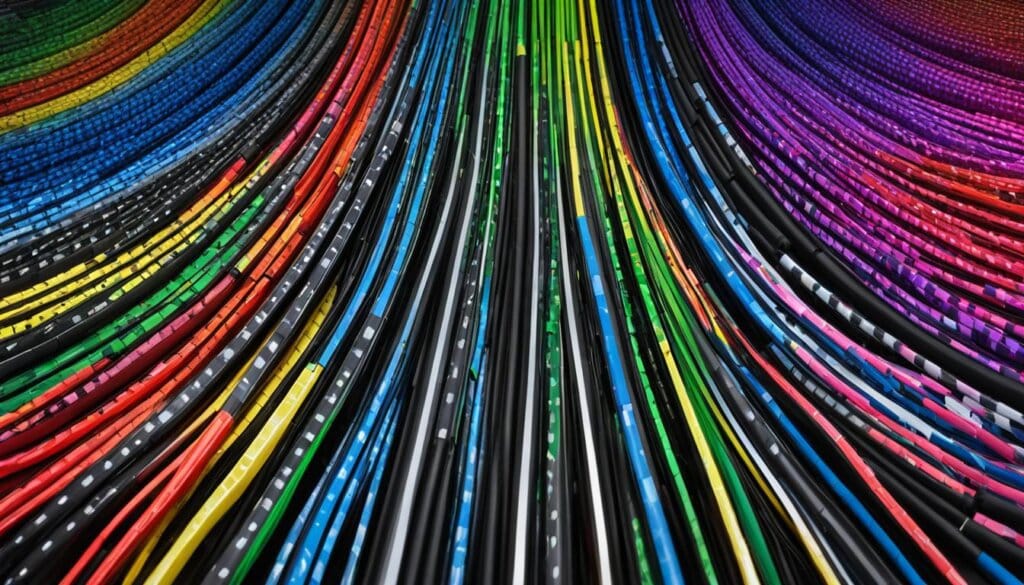Table of Contents
Fibre optic technology, also known as fiber optic technology, forms the backbone of modern high-speed data transmission. To grasp the basics of fibre optics, it is essential to delve into how it works.
Fibre optic technology utilizes thin strands of glass or plastic called optical fibers. These fibers are used to transmit light signals over long distances, enabling high-speed data transfer. A key principle in fibre optic technology is total internal reflection, where light signals bounce off the walls of the fibre optic cable to travel down the core. This transmission of data in the form of light particles, or photons, revolutionizes industries such as telecommunications, internet connectivity, and medical instruments.
In this article, we will explore the intricacies of fibre optic technology, from its fundamental workings to its applications in various industries. We will delve into the purpose of fibre optics, the mechanics behind a fibre optic cable, the different types of fibre optic cables, the advantages and disadvantages of fibre optics, and their uses in fields such as telecommunications and the medical industry. Moreover, we will also examine the benefits of fibre optic internet and its significance in today’s digital landscape.
What Is Optical Fiber (Fiber Optics) Technology?
In today’s digital age, the demand for high-speed data transfer and reliable connectivity is at an all-time high. This is where fiber optics technology comes into play. But what exactly is fiber optics, and what is its purpose?
Fiber optics, also known as optical fibers, are long, thin strands of glass or plastic that are carefully drawn to have a diameter similar to a human hair. These strands are then bundled together to form fiber optic cables. The primary purpose of fiber optics is to transmit light signals over long distances, enabling the efficient transmission of data.
The benefits of fiber optics technology are numerous. Firstly, fiber optics allows for high-speed data transfer, making it ideal for applications that require quick and reliable communication. Whether it’s streaming a movie, downloading large files, or video conferencing, fiber optics ensures a seamless experience.
Another advantage of fiber optics is its immunity to electromagnetic interference. Unlike traditional copper cables, which can be affected by external factors such as electrical currents or nearby power lines, fiber optics is not susceptible to such interference. This results in a more stable and reliable connection.
One of the remarkable features of fiber optics is its ability to carry multiple signals simultaneously. This means that a single fiber optic cable can transmit data for various applications simultaneously, such as internet, television, and telephone services. The efficiency of fiber optics in handling multiple signals makes it an incredibly valuable technology.
Now, let’s take a closer look at the benefits of fiber optics technology:
- High-speed data transfer: Fiber optics enables lightning-fast data transfer speeds, allowing for rapid communication across different devices.
- Immunity to electromagnetic interference: Unlike copper cables, fiber optics is not affected by external factors, ensuring a stable and uninterrupted connection.
- Ability to carry multiple signals simultaneously: Fiber optics can transmit data for various applications at the same time, increasing efficiency and reducing the need for multiple cables.
With its outstanding capabilities, fiber optics has become an indispensable technology in various industries. Telecommunications, internet connectivity, and medical imaging are just a few examples of sectors where fiber optics is extensively used.
As the world becomes increasingly connected, fiber optics technology plays a vital role in keeping us all linked together. Its ability to transmit light signals over long distances, high-speed data transfer, immunity to interference, and the simultaneous transmission of multiple signals make it an exceptional solution for modern communication needs.
How Does a Fiber Optic Cable Work?
A fiber optic cable operates based on the principle of total internal reflection, which enables the transmission of light signals through the cable. It consists of two main components: the core and the cladding.
The core is the innermost part of the cable and serves as the pathway for light to travel. It is made of a highly transparent material, such as glass or plastic, that allows the light to pass through with minimal loss. The diameter of the core can vary depending on the type of fiber optic cable.
Surrounding the core is the cladding, which is a layer of glass or plastic that has a lower refractive index than the core. This difference in refractive index is vital for the functioning of the fiber optic cable. It prevents the light signals from escaping the core and instead forces them to continue traveling through the cable.
When a light beam is introduced into the fiber optic cable, it undergoes a series of reflections as it bounces off the walls of the core. This bouncing is a result of the total internal reflection phenomenon, wherein the light undergoes multiple internal reflections due to the difference in refractive indices between the core and cladding. The cladding essentially acts as a barrier, confining the light to the core and allowing for efficient transmission.
In simple terms, the working principle of a fiber optic cable can be visualized as follows: Light signals are transmitted into the core of the cable and are flawlessly guided along its length, bouncing off its walls in a controlled manner until they reach the other end, where they can be received and processed.
Key points:
- A fiber optic cable uses total internal reflection to guide light signals.
- The cable consists of a core and cladding.
- The core is the innermost part and allows the light to pass through.
- The cladding, with a lower refractive index, confines the light to the core.
- The light signals bounce off the core walls in a series of reflections.
In summary, the working principle of a fiber optic cable involves the transmission of light signals through the core using total internal reflection, with the cladding keeping the light confined within the core. This allows for efficient and reliable transmission of light signals over long distances.
Types of Fiber Optic Cables
When it comes to fiber optic cables, there are two main types: single mode fiber and multimode fiber. Each type has its own unique characteristics and applications.
Single Mode Fiber
Single mode fiber, also known as SMF, is designed with a very thin core that allows signals to travel straight down the middle without bouncing off the edges. This type of fiber optic cable is commonly used for long-distance applications, such as internet and telephone communications. The narrow core ensures that the light signals propagate in a single path, resulting in less signal loss and higher transmission speeds over longer distances.
Multimode Fiber
Multimode fiber, or MMF, has a larger core compared to single mode fiber, allowing for multiple light beams to travel through the cable simultaneously. This makes it suitable for shorter distance applications, such as computer networking within a building or campus. MMF is often used to connect devices within the same local area network (LAN) and can handle higher bandwidth requirements.
Within the category of multimode fiber, there are different types characterized by “OM” (optical multimode) classifications. These classifications indicate specific bandwidth requirements. The most common types of multimode fiber include OM1, OM2, OM3, and OM4.
| Type | Core Size | Bandwidth | Application |
|---|---|---|---|
| OM1 | 62.5 µm | 200 MHz·km | LAN, data centers |
| OM2 | 50 µm | 500 MHz·km | LAN, data centers |
| OM3 | 50 µm | 2000 MHz·km | LAN, data centers, high-speed interconnects |
| OM4 | 50 µm | 4700 MHz·km | Data centers, high-speed interconnects |
The table above provides a summary of the different types of multimode fiber and their corresponding core sizes, bandwidths, and applications.
Whether it’s single mode fiber or multimode fiber, choosing the right type of fiber optic cable is crucial for ensuring optimal performance and compatibility with the intended application.

Advantages and Disadvantages of Fiber Optics
Fiber optics offer several advantages over traditional copper cables. Here are some of the key benefits of fiber optics:
- Higher Bandwidth Capacity: Fiber optics can support higher bandwidth, allowing for faster data transfer speeds and improved performance.
- Immunity to Interference: Unlike copper cables, fiber optics are not affected by electromagnetic interference, resulting in a more reliable and stable connection.
- Lightweight and Strong: Fiber optic cables are lighter and thinner than copper cables, making them easier to install and handle. They are also stronger and more durable, with a higher tensile strength.
Despite these advantages, there are also some drawbacks to consider:
- Higher Installation and Maintenance Costs: Fiber optic cables can be more expensive to install and maintain compared to copper cables. The specialized equipment and expertise required contribute to the higher costs.
- Fragility of Glass Fiber: Glass fiber, the core material of fiber optic cables, is more fragile than copper. It requires additional protection within an outer cable to prevent damage.
- Labor-Intensive Installation: Installing new fiber optic cables can be labor-intensive, as it involves careful handling, splicing, and testing of the cables. This can increase the complexity and time required for installation.
Overall, the benefits of fiber optics, such as higher bandwidth capacity and immunity to interference, make them a preferred choice for many applications. However, the higher installation and maintenance costs, fragility of glass fiber, and labor-intensive installation process are important factors to consider.
Comparison of Fiber Optics and Copper Cables:
| Advantages of Fiber Optics | Advantages of Copper Cables |
|---|---|
| Higher bandwidth capacity | Cheaper installation costs |
| Immunity to electromagnetic interference | Easier compatibility with existing infrastructure |
| Lightweight and strong | Less susceptible to damage from bending |
Fiber Optics Uses in Various Industries
Fiber optics, with its high-speed data transmission capabilities, finds widespread applications across various industries. Let’s explore some of the key uses of fiber optics:
Telecommunications
One of the primary uses of fiber optics is in telecommunications. Fiber optic cables enable the seamless transmission of high-speed data, making it possible to deliver internet, telephone, and television services to households and businesses. The use of fiber optics in telecommunications ensures faster and more reliable connections, enabling smooth communication and access to digital services.
Computer Networking
Fiber optics plays a crucial role in computer networking. By using fiber optic cables, organizations can establish faster connections between their devices, increasing data transfer speeds and reducing latency. This is essential for activities such as file sharing, video conferencing, and accessing cloud-based applications. Fiber optics also enables the development of high-performance data centers by providing efficient connectivity between servers, switches, and storage devices.
Broadcasting and Electronics
The broadcasting industry heavily relies on fiber optics for transmitting audio and video signals. By using fiber optic cables, broadcasters can ensure high-quality transmission over long distances without degradation or signal loss. Additionally, fiber optics is extensively used in electronics manufacturing to enhance the performance of devices such as sensors, cameras, and displays. The use of fiber optics in electronics enables faster data transfer, improved image quality, and more reliable connections.
Medical Field
In the medical field, fiber optics is essential for various applications. Medical instruments, such as endoscopes and surgical lasers, utilize fiber optics to provide precise illumination and visualization during medical procedures. Fiber optic cables are also employed in diagnostic imaging techniques like X-ray imaging and fiber-optic endoscopic imaging. These applications enhance medical diagnostics and enable minimally invasive procedures.
Military and Space
Fiber optics is widely used in military and space applications due to its lightweight and small size. It is utilized for communication systems, allowing for secure and reliable transmission of sensitive information. Fiber optics enables faster data transfer between military installations and enhances the overall effectiveness of military operations. In space exploration, fiber optics plays a crucial role in data transmission between spacecraft and ground stations, enabling scientists to receive valuable information from distant celestial objects.
Overall, fiber optics has revolutionized various industries by providing high-speed, efficient, and reliable data transmission capabilities. Its applications in telecommunications, computer networking, broadcasting, electronics, medical instruments, and military and space technologies have significantly advanced the way we communicate, work, and explore the world.
| Industry | Applications |
|---|---|
| Telecommunications | Internet, telephone, and television services |
| Computer Networking | High-speed data transfer, improved network performance |
| Broadcasting and Electronics | Audio and video signal transmission, enhanced device performance |
| Medical Field | Precise illumination in medical instruments, diagnostic imaging |
| Military and Space | Secure communication, data transmission in military and space applications |
Fiber Optic Internet and its Benefits
Fiber optic internet, such as Verizon Fios, provides users with fast and reliable internet connectivity. With fiber optic technology, users can experience significantly faster upload and download speeds, as well as more bandwidth for multiple devices.
One of the key benefits of fiber optic internet is its immunity to electromagnetic interference, ensuring a stable connection. This means that even in areas with high levels of electromagnetic radiation, such as near power lines or electrical appliances, users can still enjoy uninterrupted internet access.
Fiber optic internet also offers a high level of security. Unlike traditional copper cables, which can be tapped into and compromised, fiber optic cables do not emit electromagnetic signals that can be intercepted. This makes fiber optic internet a more secure option for transmitting sensitive data, such as financial transactions or personal information.
Furthermore, fiber optic internet is less susceptible to signal loss over long distances. Unlike copper cables, which can experience degradation of signal quality over extended lengths, fiber optic cables can transmit data over much greater distances without any loss of signal strength. This makes fiber optic internet a reliable choice for users who require consistent and high-performance internet connectivity.
FAQ
What is fiber optic technology?
Fiber optic technology refers to the use of optical fibers, which are thin strands of glass or plastic, to transmit light signals over long distances. It allows for high-speed data transfer and is commonly used in telecommunications, internet connectivity, and medical instruments.
What is the purpose of fiber optics?
The primary purpose of fiber optics is to transmit light signals over long distances, enabling efficient data transfer. It offers benefits such as high-speed data transfer, immunity to electromagnetic interference, and the ability to carry multiple signals simultaneously.
How does a fiber optic cable work?
A fiber optic cable works by utilizing total internal reflection to guide light signals through the cable. It consists of a core, which is the center of the cable through which light travels, and a cladding, which is a layer of glass that surrounds the core. The light beam travels down the core, bouncing off the walls in a series of internal reflections, allowing for efficient transmission of light signals.
What are the types of fiber optic cables?
There are two main types of fiber optic cables: single mode fiber and multimode fiber. Single mode fiber has a thin core and is used for long-distance applications, while multimode fiber has a larger core and is used for shorter distance applications. There are also different types of multimode fiber, identified by “OM” classifications, which have specific bandwidth requirements.
What are the advantages and disadvantages of fiber optics?
Fiber optics offer advantages such as higher bandwidth capacity, immunity to electromagnetic interference, and lighter and stronger cables. However, they can be more expensive to install and maintain compared to copper cables and require more protection due to their fragility. Installing new fiber optic cables can also be labor-intensive.
What are the uses of fiber optics in various industries?
Fiber optics has a wide range of applications in industries such as telecommunications, computer networking, broadcasting, electronics, and the medical field. It is used for high-speed data transmission, better connections and performance, precise illumination in medical instruments, and diagnostic imaging techniques.
What are the benefits of fiber optic internet?
Fiber optic internet, such as Verizon Fios, offers fast and reliable internet connectivity with significantly faster upload and download speeds, more bandwidth for multiple devices, stability, security, and less signal loss over long distances. It is increasingly becoming the preferred choice for residential and business internet services.







